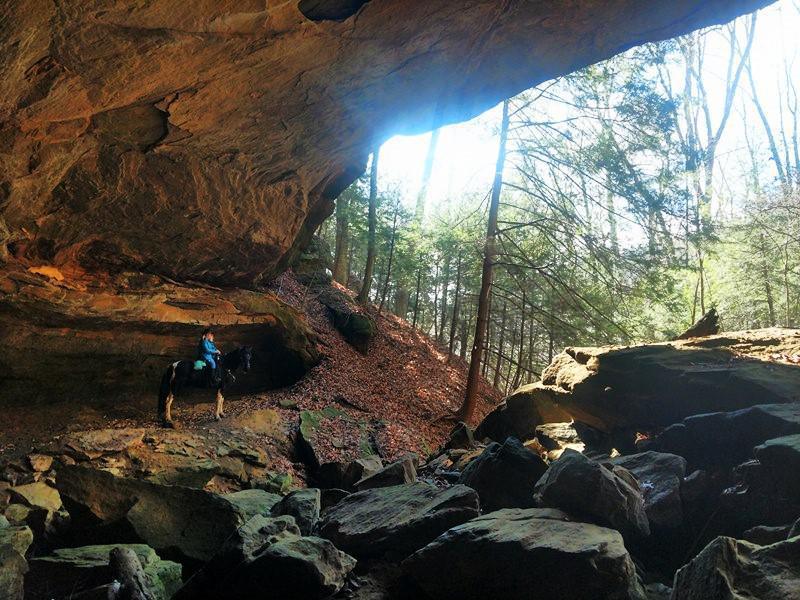Owning land next to a national forest is like having a gateway to nature and a year-round pass to our set aside lands.
In Lawrence County, Ohio, some 44 percent of the land is publicly owned, most of that belonging to the Wayne National Forest (WNF), making it the single largest neighbor to many Lawrence Countians.
If a Homeowner’s Association existed among landowners and the federal government, it would look something like the Southern Wayne Advocacy Council (SWAC). This council was developed in 2015 and consists of a varied and passionate citizens group with specific interests formed essentially to open up more public land.
Tim Dickens, who is SWAC chair, explained why the Wayne Forest blots a jigsaw pattern on a map of Lawrence County. “During the ‘30s and the Depression, the U.S. Department of Agriculture sent out land agents to buy up farms, offering impoverished farmers life estates in return for their land that would become national forest. At that time, the land had been scalped for railroad ties and charcoal furnaces.”
Cumulatively, those farms would add up to 108,000 acres in the Ironton District of the Wayne National Forest alone and a quarter of a million overall in southeastern Ohio. Today, almost 90 years’ worth of undeveloped and reforested lands are covered with the flora and fauna nature intended, and parts are as hidden as if Uncle Sam had placed an invisible privacy fence along the border.
“You wouldn’t believe how undiscovered some of these rock formations and vistas are,” Jill McCleese, SWAC member representing equestrian interests, said. “There’s so much beauty here. The first time I saw it, I was like ‘This is a sanctuary.’ One vista, on a clear day you can see all the way to the (AEP) Gavin Plant. Most people can’t believe it and more people don’t even know it’s here.”
McCleese and her husband Rick run Elkins Creek Horse Camp and Tack, hosting fellow horsemen from all over the country who come to ride nearly 50 miles of groomed horse trails within the Wayne Forest. The McCleeses and their comrades of horse enthusiasts donated over 6,000 man-hours of volunteer work on improving horse trails last year alone.
It’s this stewardship that head WNF Ranger Tim Slone of the Ironton District says the forest service desperately needs. “We serve the community in a multitude of ways. With 18 employees overseeing 108,000 acres, managing 150 miles of trails, botany, prescribed burns, timber sales, archeological resources, clean water and campgrounds, there simply aren’t enough resources to go around.”
“We realized a lot of the community saw us an obstacle instead of a catalyst,” said Slone. With a focus on land management, the connection with the actual public and its public land seemed lost. Add long established sentiments of family farms in government hands to permits that aren’t always user-friendly and the relationship between government and citizen can become contentious.
That’s where the Southern Wayne Advocacy Council (SWAC) was spawned. “You really have to see this group to appreciate it. There is such passion from each member, all representing a different interest, but with a common goal of opening up public land,” Dickens adds.
He’s right. Everyone in the 11-member strong meeting from Botanist Judy Dumke to travel and tourism leader Marty Conley to Lawrence County Director Dr. Bill Dingus are there for one reason – to improve access and interest in this unrealized jewel and, what’s more, they have the support of WNF.
Instead of talking about what could be, the group appears to be action-oriented, working toward government grants such as President Trump’s initiative to create Recreation Economy for Rural Communities. No individual within the group can pinpoint if Ironton District of WNF would become a Hocking Hills, but everyone seems to agree there is potential for more.
Dickens, who is also an avid ATV enthusiast, saw this disconnect with recreators and the WNF. He explains Wayne ATV trails were developed in the late ‘80s before the recreational vehicle industry took off and developed ever popular side-by-side vehicles that are more than 50 inches in width. Before that, it was simply four-wheelers and motor bikes.
“SWAC is lobbying to widen all those trails and bridges,” according to Dickens. Now that it is established as a nonprofit, SWAC can apply for grants such as one received from Polaris® Corporation to improve signage and trails. They also received glowing support from Honda® that sent engineers from Marysville, Ohio, to help with trail work.
The SWAC is actively working to connect two main trails over privately-owned land from Superior/Telegraph to the Hanging Rock trail areas. Another goal is to ease the hassle for out of state riders who currently have to register their ATV in the state of Ohio before they can ride WNF – something not required in neighboring states.
While this may sound like a broad scope for a citizen-led group, the passion behind the group and the support from the leaders of Wayne National Forest are well poised to make this area a recreational hot spot.
Taking Ownership: Southern Wayne Advocacy Council
Elizabeth Slagel
Comments
No comment
Be the first to post a comment


